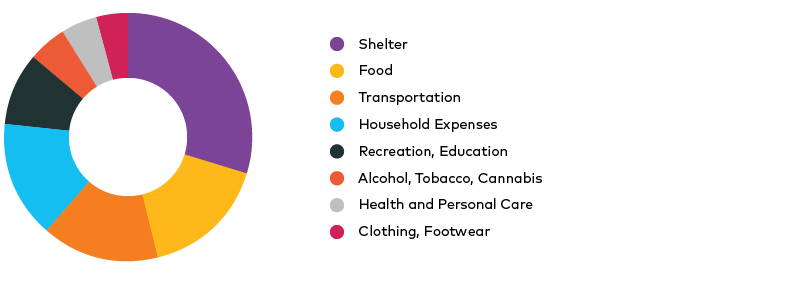What is Inflation and Why Does it Matter?
2 min readBrought to you by Sound Choices - AGF Education for Investors and Advisors
Inflation is simply an increase in prices over a period of time. Deflation is the opposite – a decrease in prices.
How is inflation measured?
The most common measure is the Consumer Price Index or CPI, which tracks the prices of about 700 goods and services in Canada and reports changes in prices on a monthly basis.
The CPI is meant to give you an idea of how much the average household spends on a representative basket of goods and services and is divided into eight major categories:
What's included in the CPI?

Statistics Canada has added hand sanitizer, face masks and disinfecting wipes to the Consumer Price Index.
Source: “The Consumer Price Index: Keeping up with Canadian Consumers.” Statistics Canada, July 21, 2021. https://www150.statcan.gc.ca/n1/pub/11-627-m/11--627-m2021058-eng.htm
How is the inflation rate calculated?
To calculate the inflation rate, they compare the prices from one time period to another.
Here’s a hypothetical example:
- Let’s say the basket of goods and services costs $100 in year one.
- In year two, that basket costs $103, an increase of $3.
- That translates into an annual inflation rate of 3%.
Why do prices go up?
Prices generally go up when demand exceeds supply.
Think of lumber prices over the past couple of years. Increased interest in home renovations during the pandemic combined with supply chain issues drove prices up to historic levels.
Or shopping for fresh fruits and vegetables – if it’s out of season, you’ll have to pay more since it’s less plentiful.
Similarly, consumers may also encounter higher prices for an item if the manufacturer has had to pay higher prices for the components needed to build their product. To maintain their profit margin, the manufacturer may charge a higher price for the end product if they believe the consumer will pay it.
Why does that matter?
On a personal level when prices go up, but your income stays the same, you can’t buy as much as you used to. This is known as a decrease in purchasing power.
If wages go up, that could impact manufacturing costs, leading to higher prices – and more inflation.
Keeping up with inflation
For example, if you were earning $100,000 a year, after 20 years you would need to earn 50% more a year – or $148,594 – to maintain the same purchasing power.
Amount of income required to maintain purchasing power with 2% annual inflation*
|
Current Income |
5 Years Later |
10 Years Later |
20 Years Later |
30 Years Later |
|
$50,000 |
$ 55,204 |
$ 60,950 |
$ 74,297 |
$ 90,568 |
|
$100,000 |
$110,408 |
$121,899 |
$148,594 |
$181,136 |
|
$150,000 |
$165,612 |
$182,849 |
$222,892 |
$271,704 |
The Bank of Canada aims for between 1% and 3% inflation over the long term – a level that means the economy is growing and the price increases are predictable enough that it won’t impact how much people spend or save.
When inflation is higher, price increases may become unstable. People and companies may start worrying about what they’re going to pay, how far their money will go and whether they’ll be forced to dip into their savings to make ends meet.
Inflation and interest rates
The economy is managed through two main avenues:
- Fiscal policy – government decisions with regards to taxes and spending
- Monetary policy – central bank either increasing or decreasing money supply and interest rates
In an environment when inflation is going up, interest rates will be increased to encourage higher savings and lower spending, which in turns slows the economy and inflation.
We’ve been in an environment with inexpensive credit for a long time – with lower interest rates, people tend to borrow more – and spend more. Consider the Canadian housing market, for example, where a potential increase in interest rates could affect how consumers spend even further. Read “It Pays to Pay Attention to Interest Rates” to learn more on this specific topic.
How are investments in your portfolio impacted by inflation?
If you hold money in an investment account, inflation can also affect your returns. For example, if the inflation rate is 4.0% and your tax rate is 30%, your investment would need to grow by 5.71% annually just to break even.
|
Inflation |
1.0% |
2.0% |
3.0% |
4.0% |
|
Tax rate at 20% |
1.25% |
2.50% |
3.75% |
5.00% |
|
Tax rate at 30% |
1.43% |
2.86% |
4.29% |
|
|
Tax rate at 40% |
1.67% |
3.33% |
5.00% |
6.67% |
For equity investments, some sectors do well during periods of rising inflation. These are the goods and services that you have to buy regardless of how much they cost. However, the discretionary sectors (representing the items you can cut from your budget) obviously don’t do well during these times.
With regards to fixed income investments, remember that the central banks tend to fight inflation by raising interest rates. When interest rates rise, bond prices fall. This is because if interest rates go up, investors can access a bond with a higher interest payment – so the attractiveness (and value) of the bond with the lower interest rate goes down.

To find out how you can inflation-proof your investments, contact your financial advisor and read “Protect Against Inflation” in the Portfolio Strategies section on AGF.com.
All information in Canadian dollars unless otherwise stated. For illustrative purposes only. Commissions, trailing commissions, management fees and expenses all may be associated with investment fund investments. Please read the prospectus before investing. Investment funds are not guaranteed, their values change frequently and past performance may not be repeated.
This content is provided as a general source of information and is not intended to be comprehensive investment advice applicable to the circumstances of the individual. Every effort has been made to ensure accuracy at the time of publication, however, accuracy cannot be guaranteed. Market conditions may change and AGF Investments accepts no responsibility for individual investment decisions arising from the use or reliance on the information contained here.
The contents of this website are provided for informational and educational purposes and are not intended to provide specific individual advice including, without limitation, investment, financial, legal, accounting or tax. Please consult with your own professional advisor on your particular circumstances.
AGF Investments is a group of wholly owned subsidiaries of AGF Management Limited, a Canadian reporting issuer. The subsidiaries included in AGF Investments are AGF Investments Inc. (AGFI), AGF Investments America Inc. (AGFA), AGF Investments LLC (AGFUS) and AGF International Advisors Company Limited (AGFIA). AGFA and AGFUS are registered advisors in the U.S. AGFI is a registered as a portfolio manager across Canadian securities commissions. AGFIA is regulated by the Central Bank of Ireland and registered with the Australian Securities & Investments Commission. The subsidiaries that form AGF Investments manage a variety of mandates comprised of equity, fixed income and balanced assets.
® The “AGF” logo and “Sound Choices” are registered trademarks of AGF Management Limited and used under licence.
RO 2041222
February 22, 2022